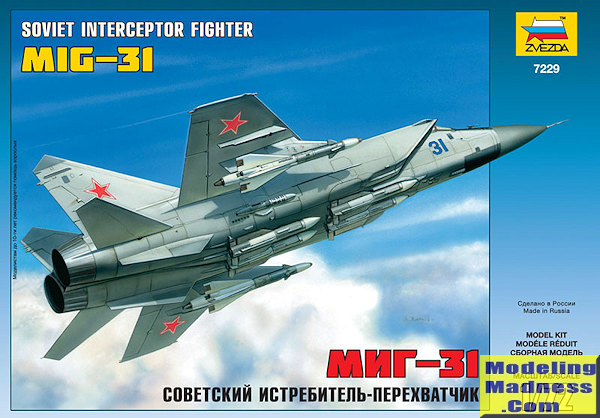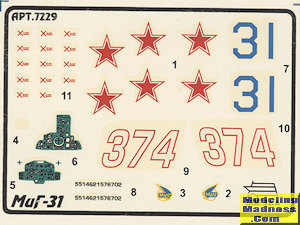
Zvezda 1/72 MiG-31
| KIT #: | 7229 |
| PRICE: | $22.00 |
| DECALS: | Two options |
| REVIEWER: | Scott Van Aken |
| NOTES: | 2004 tooling |

| HISTORY |
The Mikoyan MiG-31 (Russian: Микоян МиГ-31; NATO reporting name: Foxhound) is a supersonic interceptor aircraft developed for use by the Soviet Air Forces. The aircraft was designed by the Mikoyan design bureau as a replacement for the earlier MiG-25 "Foxbat"; the MiG-31 is based on, and shares design elements with the MiG-25. The MiG-31 has the distinction of being one of the fastest combat jets in the world. It continues to be operated by the Russian Air Force and the Kazakhstan Air Force following the end of the Cold War and the collapse of the Soviet Union in late 1991. The Russian Defence Ministry expects the MiG-31 to remain in service until at least 2030.
MiG-31 production ended in 1994. A total of 519 MiG-31s were produced of which 349 "baseline models" were produced at the Sokol plant between 1976 and 1988. The second production batch of 101 Mig-31DZ's were produced between 1989 and 1991. The final batch (Mig-31B) of 69 aircraft were produced between 1990 and 1994. Of this final batch, 50 were retained by the Kazakhstan Air Force after the dissolution of the Soviet Union. Of the "baseline models," 40 airframes were upgraded to Mig-31BS standard.
| THE KIT |
 This
is not a new Zvezda kit, having come out in 2004. You can tell that by the kit
number, which is fairly low. A year later, a MiG-31B was released, making the
original kit a baseline version. The kit has also been reboxed by Revell AG.
Overall, it is a nice looking kit. Engraved panel lines may be a bit much for
some, but as they say, some of that will be tempered by paint.
This
is not a new Zvezda kit, having come out in 2004. You can tell that by the kit
number, which is fairly low. A year later, a MiG-31B was released, making the
original kit a baseline version. The kit has also been reboxed by Revell AG.
Overall, it is a nice looking kit. Engraved panel lines may be a bit much for
some, but as they say, some of that will be tempered by paint.
I should point out that this kit supposedly has the prototype intakes, though how they differ from the production ones escapes me as they do look the same. If you can fill me in on the differences so I can modify this one when I build it, I'd appreciate it.
The kit's interior is best described as Spartan. Simply a tub, two seat shapes, two pilot figures and control sticks that are placed in small pedestals that jut up from the tub floor. Instrument panels are supplied with decals and these fit in the upper nose section. Cockpit canopies are provided and can be posed open. Other modelers have commented that they don't fit well closed so keep that in mind.
The aft fuselage is built up with a base floor section with side panels into which the main gear wells are attached. The nose well is built into the lower nose section and there is plenty of room for the 7 grams of nose weight recommended. Main gear legs are a bit soft in terms of detailing. In fact, that is a comment from several who have already built this kit. They recommend the newer tooling of the ICM kit if building this aircraft. However, the new and old tool share the same box and kit number so you don't know what you are getting until you open the box. This kit's exhaust looks a bit odd as I've not seen a conical shaped final compressor on an engine before. The burner cans are paired and look good enough.
This kit can be modeled in flight so you get two different positions of the intake ramp depending on which you are doing. The aft fuselage upper and lower sections traps the one piece wing. Added to this are the ventral strakes, fins and tail planes along with the parabrake housing. The nose section is attached prior to completing the intake assembly. This has separate lower lips for ground or in-flight. Though the instructions would have you attach the main gear prior to all this, it isn't until you build up the nose gear that the instructions have to choose between gear up and gear down options. A rather odd way to do it. There are speed brakes that can be posed down if one wishes. We are not without things under wings and you have two large fuel tanks as well as a variety; of missiles and a centerline gun. If you remembered to open the hole in the lower fuselage, you can put all this on the included display stand.
I nstructions
are adequate but not really that good. It is recommended that you locate a set
of the instructions from the Revell AG boxing as they are much better. Markings
are for two planes. One is a display plane #374 from 1991 with lots of blue and
black areas over the standard 'light ghost grey' paint. All of the various
stripes and such will need to be painted by the modeler, but will make for a
striking model. The other is bort 31, a 'serial' fighter. The small decal sheet
is typical of early Zvezda kits so one is not sure how well it will work.
Fortunately, there are aftermarket sheets out there for the MiG-31. There are
also a number of aftermarket bits available for the cockpit and the rest of the
airframe should you be so inclined.
nstructions
are adequate but not really that good. It is recommended that you locate a set
of the instructions from the Revell AG boxing as they are much better. Markings
are for two planes. One is a display plane #374 from 1991 with lots of blue and
black areas over the standard 'light ghost grey' paint. All of the various
stripes and such will need to be painted by the modeler, but will make for a
striking model. The other is bort 31, a 'serial' fighter. The small decal sheet
is typical of early Zvezda kits so one is not sure how well it will work.
Fortunately, there are aftermarket sheets out there for the MiG-31. There are
also a number of aftermarket bits available for the cockpit and the rest of the
airframe should you be so inclined.
| CONCLUSIONS |
For those of you who might remember, many years ago, Revell had a kit of the MiG-31. I owned it but never built it as I had heard that it was pretty lame (like the A-6 and RA-5C they had at about the same time). This one will not wow the crowd as MiG-31s are generally pretty bland aircraft, devoid of a mass of special markings and fancy paint schemes unless it is a company demonstrator. However, it is an important type and deserves to be in any MiG collection.
| REFERENCES |
https://en.wikipedia.org/wiki/Mikoyan_MiG-31
May 2016
Copyright ModelingMadness.com
Thanks to me for the preview kit.
If you would like your product reviewed fairly and fairly quickly, please contact the editor or see other details in the Note to Contributors.